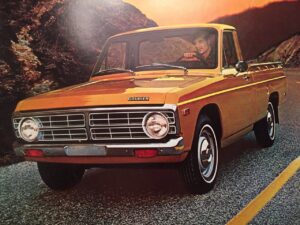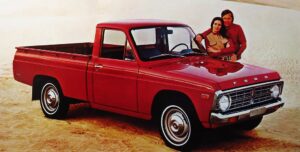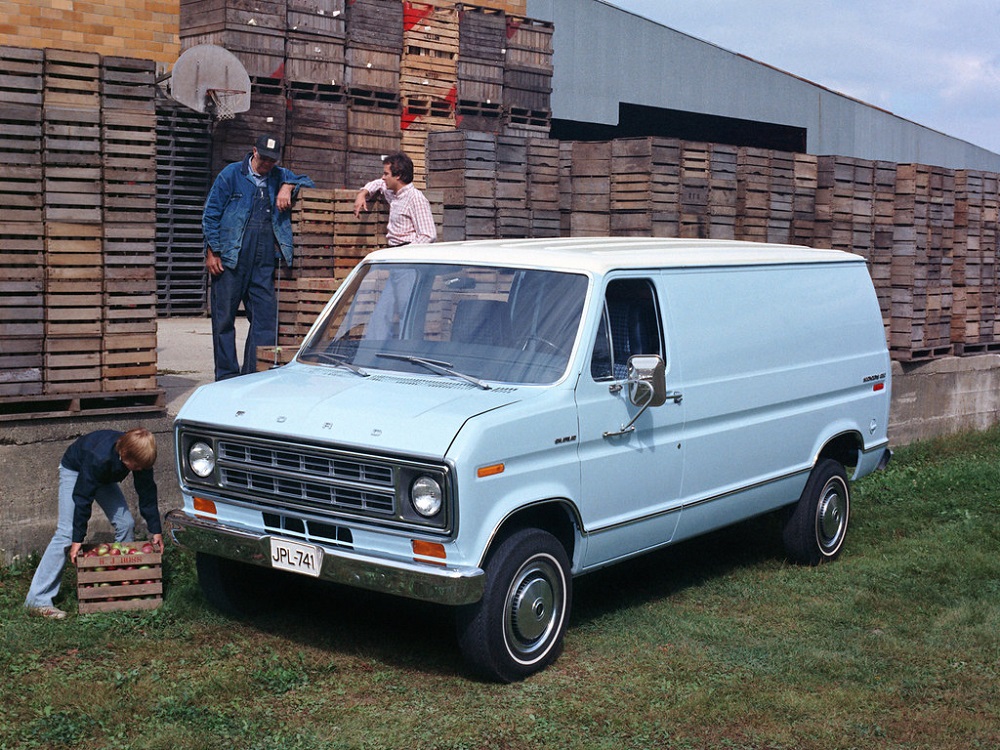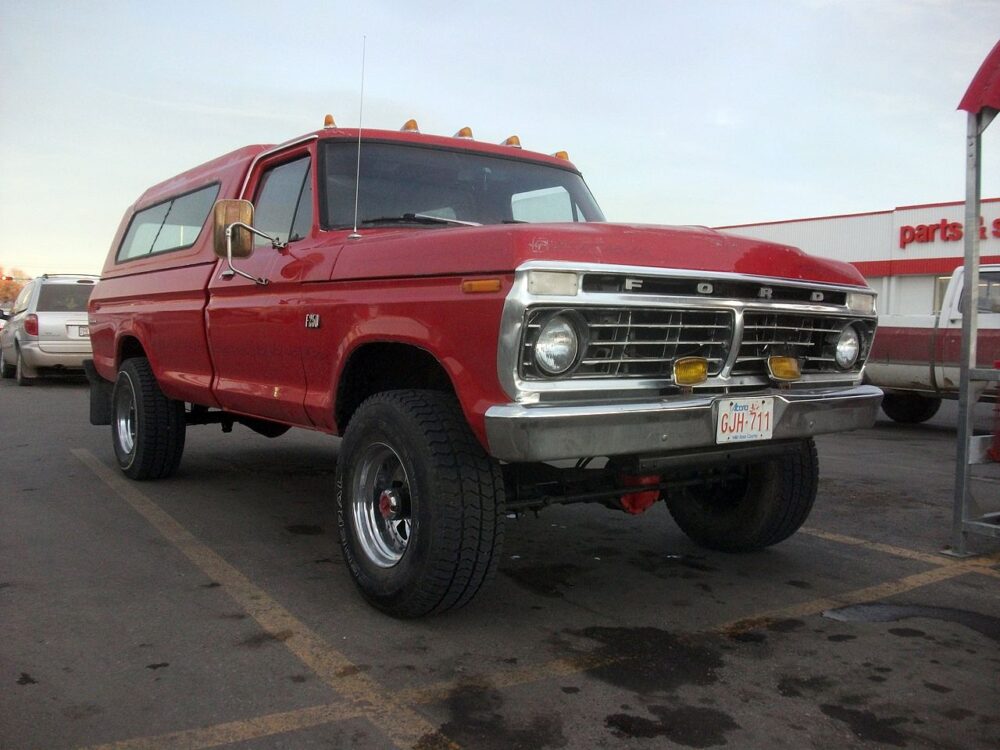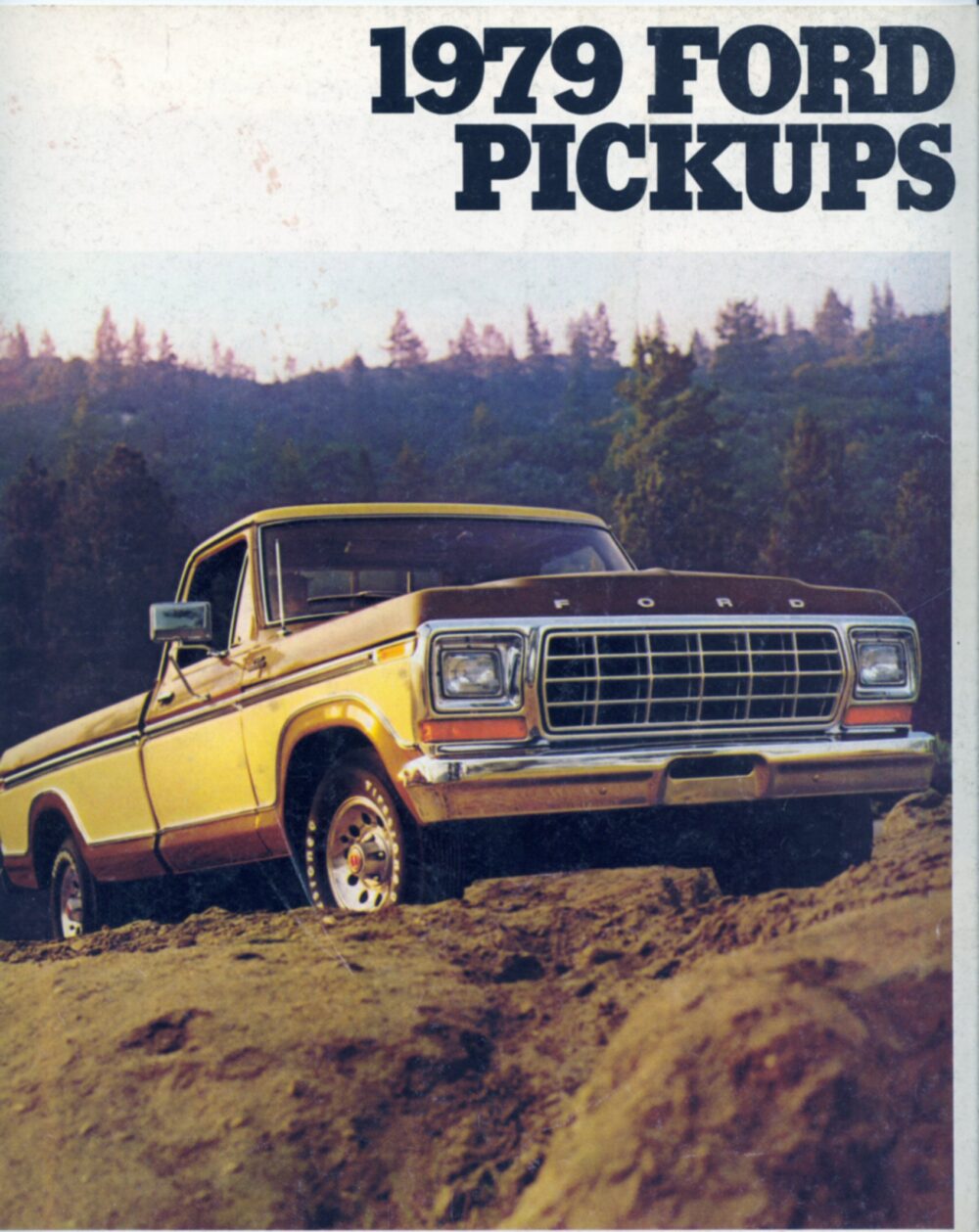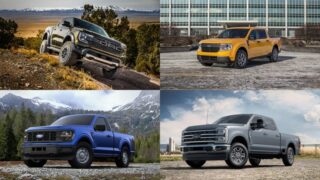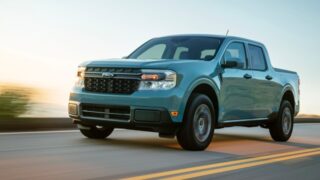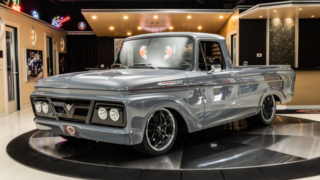Ford Truck History Part 4: 1973-1979
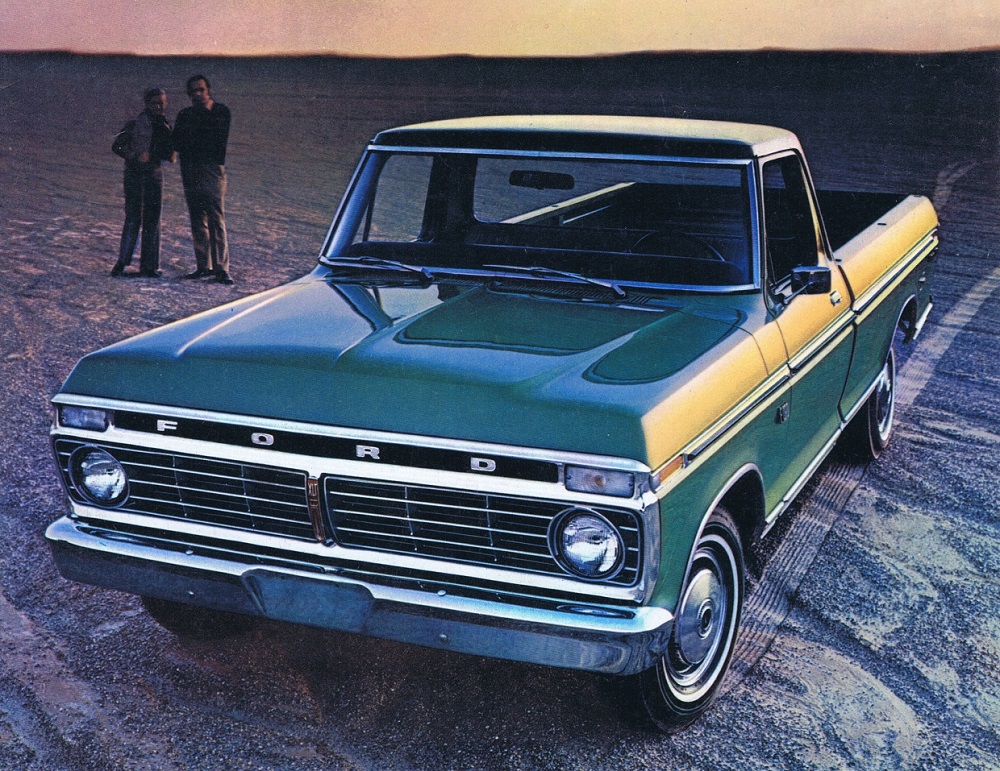 In the 1970s, Ford tackled new competition from overseas, and became America’s best-selling vehicle in spite of the Oil Crisis.
In the 1970s, Ford tackled new competition from overseas, and became America’s best-selling vehicle in spite of the Oil Crisis.
Welcome to is Part 4 of our Ford truck history series. Here’s where we’ve been so far:
Part 1: F Series Origins
Part 2: 1953-1960
Part 3: 1961-1972
The allure of the Japanese car market thoroughly hooked the United States by 1970. Offerings from Toyota, Datsun, and Mazda, in particular, grew in popularity with people looking for a small, inexpensive compact truck. This brought about the mini-truck craze that established a firm foothold once the Oil Crisis set in (more on that in a bit). Ford, on the other hand, specialized in the bigger stuff. Even the Ranchero was essentially a mid-size car and was easily expensive than a Datsun or Toyota. And with the sixth-generation F-series due out for the 1973 model year, Ford took a leap of faith with Mazda.
Mazda and West Germany-based NSU competed to be the first to create a Wankel-powered production car. NSU won with the 1964 Spider, but was unable to pefect the engine design.
In the early 1960s, Mazda didn’t hold much sway overseas and soon found itself in financial trouble. However, after they adopted the radical new Wankel engine design, the brand saw a sudden resurgence in popularity. People quickly warmed up to the funky little engine that produced quite a lot of power in a very compact package. And by 1971, Mazda was back on the map, albeit still with empty pockets. At this point, Mazda entered an agreement with Ford, becoming the first international joint-venture of its kind in the automotive industry. Ford acquired a little over 20% stake in Mazda, and in exchange, Mazda granted Ford the rights to produce the B-Series under license. This deal bore fruit almost immediately, thanks to the Oil Crisis forever altering the motoring landscape.
A Quick Recap
The 1973 Oil Crisis began with the January 1973 stock market crash, followed up by the Yom Kippur War in October. Saudi Arabia proclaimed an oil embargo on countries that supported Israel, hiking up the prices from $3/barrel to almost $12/barrel practically overnight. This wasn’t the first time Arab nations have used oil as political leverage, though it remains the most impactful. The crisis impacted the automotive industry particularly harshly, not only because of oil used as fuel, but also as lubricants and in construction materials like plastic. Efficiency quickly became the priority, leading most manufacturers – Ford included – to detuning their large-displacement engines in the name of sipping gas. Meanwhile, early emissions technology implemented in 1974 were primitive, and the de-tuned engines actually drank more gas than before as they were simply too lethargic to get up to speed. This began the “Malaise Era” of automobiles in the US.
Advertisements often directly targeted economy and budget-conscious consumers, such as this Pinto ad.
This shift occurred too suddenly for most US manufacturers, who were still producing mid-size cars as their bread-and-butter. Without any development time, designs were adapted to suit the dwindling market. Ford itself experienced success and failure here, with vehicles such as the Pinto and Mustang II. However, full-size trucks were in a unique impasse. Ford developed the F-series and larger B-series to suit roles inherent to their size. You can’t exactly adapt to a niche like that. Much like standardized rail gauge on a railroad, pickups featured their own systems of standardization. Bed sizes were developed to fit specific lengths of wood, or towing capacity set to certain weights, for example. So rather than lessening demand for these trucks, the oil crisis actually bumped up full-size truck sales as specialized work vehicles. Furthermore, an entire pickup subculture was in full swing at this point, which we’ll get more into later.
The Dentside
The mini-truck craze is an entire animal unto itself, but always remained thoroughly separate from the big stuff. The reasons for this are because of the standardizations, as mentioned before, as well as their versatility and cargo capacity. Put simply, a 1972 F-100, while undoubtedly more expensive than a Datsun Truck, was also a far more capable hauler. Because Ford’s production expanded to mini-trucks in 1972, they doubled down on this philosophy for the sixth-generation F-series. For the 1973 model year, Ford introduced a new body design on the same 5th-gen chassis, the Dentside. So-called because of the indentation running along the sides of the truck, the Dentside was essentially a direct continuation of the previous generation, but with several important differences. The most significant revision was the introduction of two weight categories: the F-350 V8, and F-150.
Ford designed the F-350 with the same wheelbase requirements as the standard trucks, leading to a proportionally far longer bed in comparison to other F-series models.
The F-350 in particular was a popular option for big jobs, introduced as a model for dedicated tradesmen and camping enthusiasts. To compete with the dedicated motorhome market, you could even option up a 350 with the Camper Special package, built specifically for the heavy slide-in camper. As for the F-150, that rapidly became the most popular model. The reasons behind this success were largely due to the oil crisis.
When the new emissions standards commenced, it affected light trucks substantially. The problem was that, as stated before, new emissions techniques weren’t yet perfected. Trucks carrying heavy loads suffered from substantial performance loss and fuel consumption. Ford’s answer to this problem was the F-150, with a slightly higher GVWR of 6,050 pounds but, crucially, the optional 7.5L V8. It wasn’t designed as a runaway success, but happened to fill that gap perfectly. Within two years of its introduction, the F-150 became the best-selling truck in the US, a title it’s held ever since.
The F-150’s first year on top of the food chain, 1977, saw 367,374 units leave the factory.
The Other End of the Spectrum
But before Ford accidentally produced what many argue was the best truck to come out of the Malaise Era, they were capitalizing on a different market. If you remember, back in the 1950s Ford discovered that a large part of its customers bought trucks as daily drivers. These people weren’t taking trucks to job sites. They were putting groceries and their kid’s bicycle in the bed. When Japan began exporting its trucks to US shores, it opened up the floodgates of what became known as the mini-truck craze. As mentioned before, Ford seized an opportunity with financially-stricken Mazda, reviving the Courier nameplate and officially entering the mini-truck arms race.
Ford first used the Courier nameplate on the 1952 Courier, a delivery body style for Ford’s full-size sedan.
The Courier was exactly what it said on the tin – a compact-sized Mazda pickup, rebadged as a Ford. To circumvent the heavy import taxes, Ford originally imported cab-only trucks and had the beds shipped separately before mating them in the US. They certainly weren’t the only ones – GM used the same trick with its rebadged Isuzu Faster (Chevy LUV), also introduced in 1972. The Courier was a small, understated truck with a very reasonable $3000 MSRP, equipped with a 1.8L 4-banger and 4-speed. While they weren’t built as haulers, they could still accept 1400 pounds of load. Not bad for such a small package.
The Courier continued well into the 1980s, seeing one generational redesign in 1977. Ford even equipped this generation with its own powertrain, the LL23 Pinto engine. Couriers, and mini-trucks in general, gradually phased back into light-duty trucks by this point, however. Their history, although brief, is well-storied and is ultimately beyond the scope of this overview.
The Courier had an electric variant, the ElectraVan 750, using Jet Industries DC-electric motors, produced between 1979-1982.
The Big Guns
The F-150’s runaway success effectively blindsided Ford (not that they were complaining). However, this was far from the only variant experiencing success in spite of the economy. The medium and heavy-duty vehicles also received new leases on life. Primarily, the heavy-duty B-series became the quintessential school bus throughout the ‘70s to ‘80s, as well as continuing its service as a fire truck and ambulance. Likewise, Ford followed up the E-series with a complete redesign in 1975, becoming America’s first body-on-frame van. This not only increased the parts-commonality between the E and F-series, but also totally overhauled the van’s underpinnings. In short order, the E-series became a versatile platform for everything from passenger-carrying to box-van duties. By 1978, the E-series was so well-received that it was awarded Motor Trend’s first-ever Truck of the Year award.
The LWB variant of the E-Series was the longest-wheelbase van sold commercially until 1990.
Meanwhile, the F-series’ medium-duty offerings also found themselves on the pedestal of greatness, but in a very different way. Ford’s F-250 4×4, known affectionately as “High Boy” due to the divorced transfer case raising the ride height by almost 6 inches, was the subject of extensive modification by one Bob Chandler. What started as a promotion for his 4×4 shop quickly became the genesis of a cultural phenomenon: the monster truck. Ford officially married the transfer case to the transmission in 1975. But the extra ground clearance and ease of production the divorced layout offered led Ford to continue production until 1977.
Photo by Dave. The 1977 Highboy marked the last time the “divorced” configuration was used by a major manufacturer in 4×4 production.
More medium-duty work bled over to light-duty designs during this timeframe as well. For example, Ford equipped the F-100 with an extended cab for the first time in 1973. This was largely thanks to repositioning the fuel cell to below the bed as opposed to behind the cab, improving both safety and cabin space.
The Last (Old School) Muscle Truck
Ford ended the production of its sixth-generation F-series in 1979. In many ways, this marked the end of an era for the F-series. Ford offered the 460ci V8 for the last time in 1979. It was the first year for the characteristic square headlights we know today. And it was the last time we’d see the frame underpinnings that date to 1965. However, this isn’t even the halfway point for Ford Trucks’ lifetime. As it turned out, Ford was just getting the ball rolling. And by 1980, the F-series picked up so much momentum that Ford had some mighty big shoes to fill.
Today, enthusiasts prize their ‘60s and ‘70s Ford trucks for their simplistic, rugged looks, big-block V8 power, and durability. Many other nations, especially in South America, retain these vehicles as service trucks, a testament to their durability and timelessness. Truly a vehicle worthy of being the first branded, “Ford Tough.”
Ford produced the Bronco as a direct descendant of the F-series for the first time in 1977-1979, being based on a SWB F-series chassis.
Additional photos by Wikimedia Commons





